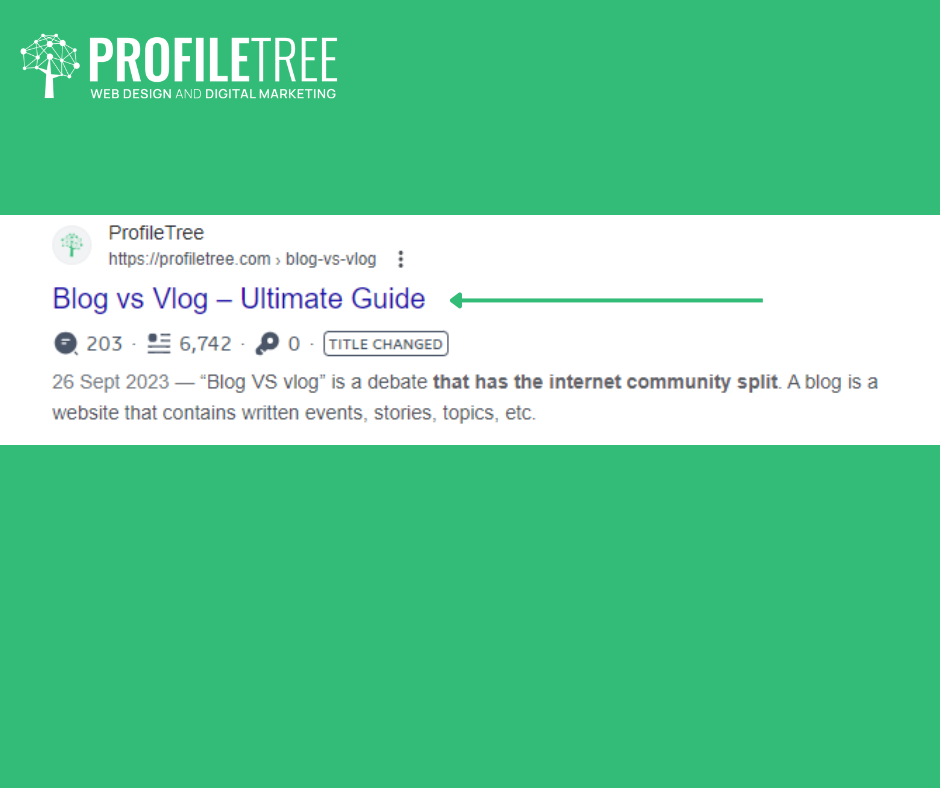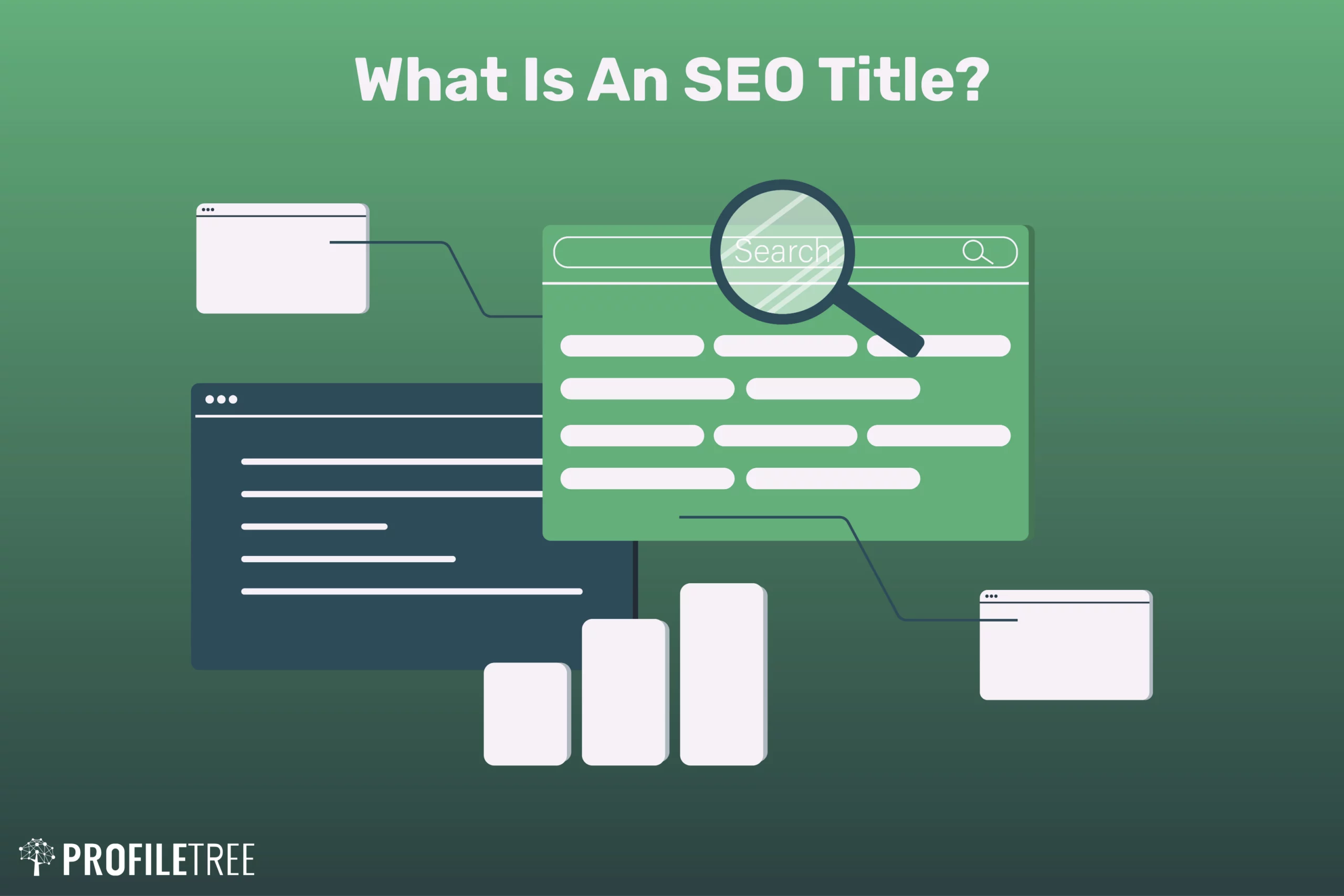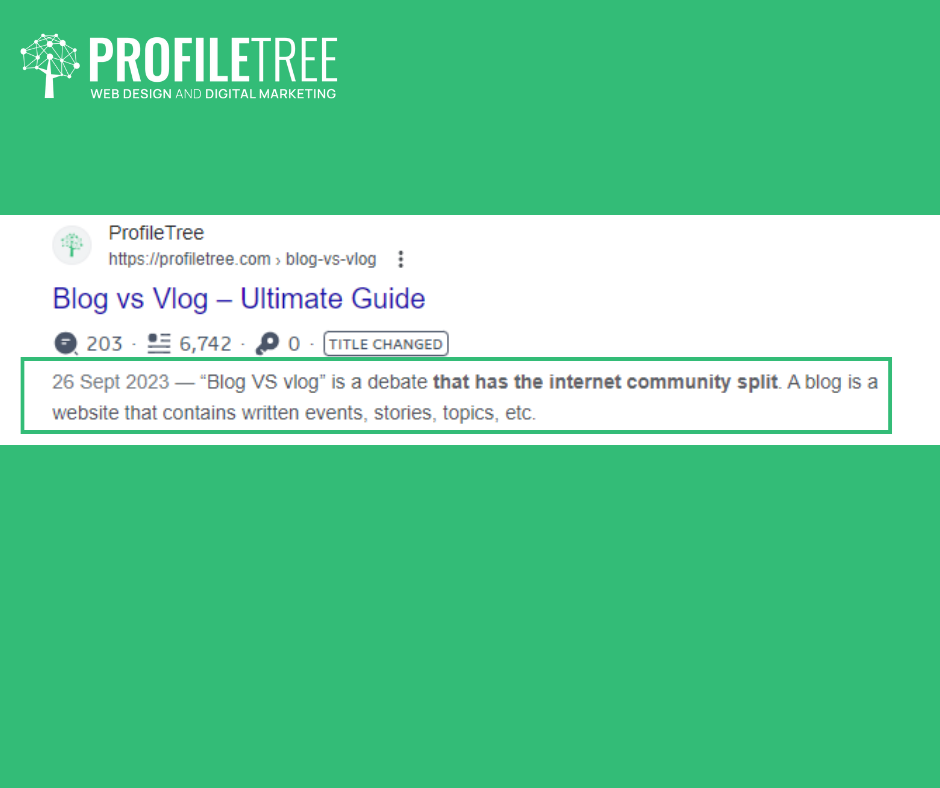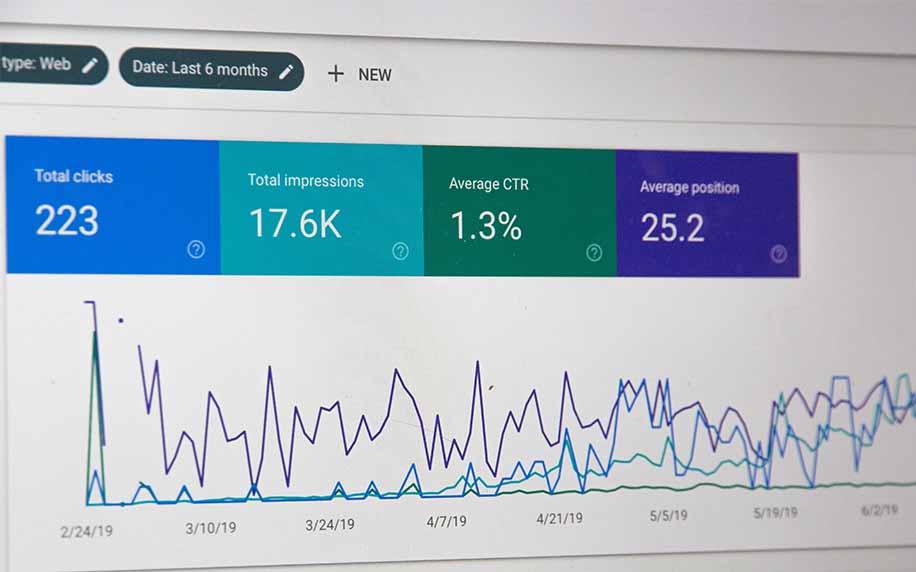What is an SEO title? A simple question, yet a vital consideration for the success of your website. An SEO title can also be called a title tag and is part of a site’s meta data, along with the meta description.
It is important to bear in mind that the title tag is in the HTML code of the website and is displayed in search engine results. That’s why the title tag should be an accurate representation of what content is found on the page.
Table of Contents
What Is an SEO Title (Definition)
An SEO title, also known as a title tag, is a fundamental element in search engine optimisation that provides a concise and accurate description of a webpage’s content. It appears as the clickable headline in search engine results pages (SERPs) and is also displayed on the browser tab when the page is viewed. Crafting a compelling and keyword-relevant SEO title is pivotal as it influences click-through rates, user experience, and search engine rankings by helping search engines and users alike to comprehend the primary focus of a webpage.

What Is an SEO Title: How Long Should an SEO Title Be?
An SEO title, often regarded as the title tag, plays a crucial role in enhancing the visibility of web pages on search engines and providing a succinct description of the page’s content to users. Google, for instance, commonly displays the first 50–60 characters of a title tag. Keeping the title within this length ensures that vital information is not cut off and that users and search engine algorithms can quickly understand the main focus of the page.
Crafting a title that is concise, compelling, and keyword-rich within this character limit can significantly boost click-through rates and positively influence search engine rankings. However, it’s essential to note that adhering to character count should not compromise the quality and relevance of the title to the page content and user intent.

What Is an SEO Title: Why Use Title Tags?
Title tags are important for SEO, and many experts consider them a factor in helping search engines see your website so you can get results. There are three main areas where title tags are used: search engine results pages, web browsers and social networks. When a potential customer is looking in the search engine, the first thing they will see is your title tag.
This is the searcher’s first experience with your site, so it can be a determining factor for whether someone clicks on your website or not.
What Is an SEO Title: Title Tags VS H1 Headings
The title tag also displays on the top of your web browser. This is especially important for people that have a lot of browser tabs open at once.
You want your title tag to be recognisable with keywords in the front, so that people don’t lose track of your content.
If someone is doing research for a product or service, they may have multiple tabs open, so your title tag should be unique but still properly explain the content on that page so people return to it.
When users post a link on social networks, many times the title tag will be shown in the link preview.
Some social networks like Facebook allow you to change what appears so it differs from your main title, but the title tag of your website is usually the default.
The title tag should not be confused with the heading that users see on the page.
The heading of the page can be referred to as the heading tag or the H1 tag.
The H1 tag should be different from the title tag. This allows another opportunity to explain to users the content of the page and allow you to add keywords to the page.
What Is an SEO Title: Tips to Create Compelling Title Tags
When writing title tags, there are some recommendations in order to optimise for both search engines and usability.
- Incorporate Keywords: Use relevant keywords that align with the page’s content and place primary keywords toward the beginning of the title.
- Limit Length: Keep the title between 50-60 characters to prevent truncation in SERPs.
- Be Descriptive: Ensure that the title accurately describes the page content and provides enough context to help users understand what the page is about. If you are not good at creating descriptive titles then you can get assistance from any AI paraphrasing tool like Paraphrasingtool.ai, Editpad, Wordtune, Jasper, and more.
- Use Readable Language: Employ natural and conversational language, avoid stuffing keywords, and ensure smooth readability.
- Invoke Curiosity: Utilise language that sparks interest and encourages clicks.
- Include Branding: Consider adding your brand or website name, typically at the end of the title.
- Avoid Duplication: Ensure each page on your site has a unique title tag.
- Leverage Localisation: If applicable, use geo-targeting by including city or regional names.
- Utilise Numbers and Dates: Numbers (like “7 Tips for…”) and current years can attract attention.
- Use Power Words: Incorporate words that provoke emotions or urgency (e.g., “Ultimate,” “Essential”).
- Utilise Proper Formatting: Separate phrases or brand names with hyphens (-) or pipes (|) for clarity.
- Optimise for Voice Search: Consider how people might express queries verbally.
- Ensure Consistency: Align the title tag with the content and meta description.
- Test and Optimise: Experiment with different titles and observe performance through analytics.
Remember that while the title tag is a vital aspect of on-page SEO, it should be balanced with the overall user experience and content quality. Always prioritise providing value and relevance to your audience.
What Is an SEO Title: SEO Title Keywords
Add keywords, but don’t overuse them. If you start keyword stuffing your title tags, Google may catch on to it, and it also provides a bad experience for the user, who may not want to click on your website. Titles should not just be a list of keywords or different variants of the same keyword.
Put the important keywords first. According to some research, the keywords that are listed first have more of an impact on search engines.
As part of the user experience, people are only going to scan the first few words. This is why the first words should be the most important. Avoid titles that start with the brand name in order to avoid having too many titles with just repetitive information.
If your title tag does get cut off in the search engine, then the most important information will appear first. Every page should have a unique title tag. This helps search engines know that your content is unique, and it will help drive higher click-through rates.
For websites with a lot of pages, this can seem like a daunting task, but there are tools available to help craft title tags that are driven by the content on the page.
If your website is in WordPress, there are SEO in WordPress tools that can do this for you, especially for product categories and product pages. Avoid any default tags, such as “Home” or “New Page.”
This could cause Google to think that you have duplicate content across your website or other websites in general.
These types of title tags reduce click-through rates since users won’t know if the information they are searching for is going to be on that page.
What Is an SEO Title: Your Brand in Your Title Tag
Some argue that it’s not necessary to put your brand in the title tag, but adding your brand can help raise brand awareness. At the same time, if you have a well-known brand, it could help boost the click-through rate.
However, it’s still advisable to put your brand at the end of the tag so you avoid having an important keyword cut off and give more weight to the keyword instead of the brand.
The right format should be Primary Keyword-Secondary Keyword-Brand Name for proper SEO.
Even though title tags are an important part of SEO, it’s necessary to write for your customers. You want to attract customers who will find your content valuable. When you are thinking about the user experience on your website and thinking about targeting visitors, it will benefit your SEO.
According to UppercutSEO, a leading SEO Services Agency,Use relevant keywords that align with the page’s content and place primary keywords toward the beginning of the title.
What If Google Isn’t Using Your Title Tag?
Google may choose not to display the title tag you have indicated for a few reasons. If your title doesn’t match the searcher’s query, Google may decide to display something else. This isn’t necessarily bad, but if your title is being overruled for keywords that have higher search volume, you may want to rewrite it so that it can match better.
If your title is too stuffed with keywords, Google won’t display it, and it’s a good idea to rewrite it in order to gain optimal search results. You may have an alternative title set up in your code for social networks, and Google may choose to pull that one instead. If it’s creating too much of a problem, it’s best to rewrite them.
What Is an SEO Title: SEO Description
A meta description should typically be between 150 and 160 characters in length. This character limit ensures that it fits well within search engine results pages (SERPs) without being truncated. The meta description serves as a brief summary of a web page’s content and is meant to entice search engine users to click on your page when it appears in search results.

It’s pivotal to make sure it is not only concise and complete within the recommended character count but also that it accurately reflects the page content, incorporates relevant keywords, and is compelling enough to attract user clicks. Even though meta descriptions are not a direct ranking factor in Google, a well-crafted meta description can significantly enhance click-through rates, thereby positively impacting traffic and potential conversions.
Tips for SEO Descriptions
Since the meta description is a function of advertising copy, it needs to be compelling. Content should include keywords, but it still needs to be relevant and really explain what users can find on that page. When displaying the meta description, Google and other search engines will often bold the keywords so that users can see what matches the query they typed in.
Just as with title tags, you want to have a unique meta description for each page, and similarly, there are ways to automate meta descriptions.
Characters and Social Media
Don’t use double quotation marks in a meta description because Google will cut off the description at that point when it appears in the listing. The best practice is to remove all alphanumeric characters. Meta descriptions are also used on social media links.
If there is no meta description, the site may just pull the first text it sees, which could lead to a bad user experience for those who are coming to your website from the social site. Sometimes, Google will identify a snippet of text for the page that it thinks matches the searcher’s query better and will display that as the meta description.
This can be unpredictable, so don’t be alarmed if you see this happening in search results.
Title Formats and Frameworks
When structuring SEO titles, there are some proven frameworks that can help. Here are some effective formats to consider:
Keyword-Centric: [Key phrase] – [Brand]
This puts the most important keywords right up front. For example:
“Dog Training Tips – PetSmart”
“Time Management Strategies – John Smith Life Coach”
Question-Based: [Key phrase] + [Question]? – [Brand]
Leading with an intriguing question that incorporates keywords can drive clicks. For example:
“How to Crate Train Your Puppy? – PetSmart”
“Struggling With Time Management? Here Are 5 Tips – John Smith Life Coach”
Problem-Agitate-Solve: [Problem] + [Key phrase]? Here is the [Solution] – [Brand]
This format highlights a problem and shows the brand can solve it. For example:
“Struggling to Potty Train Your Dog? Here are 5 Effective Tips – PetSmart”
“Feel Like You Don’t Have Enough Time? Here are 5 Time Management Hacks – John Smith Life Coach”
No matter which format you choose, ensure the primary focus keywords appear early in the title. Keep the title concise, under 65 characters. And include prominent branding. Experiment with different formats and measure results to determine what resonates most with your target audience.
What Is an SEO Title: What Is an SEO Slug
You may have heard of the term SEO slug and could be wondering if it’s the same thing as a title tag or meta description. It’s actually the editable part of a URL.
If you are writing a blog post in WordPress or another content management system, you will see that the URL will be something like: yourwebsite.com/blog/title-of-blog.
The SEO slug and URL will appear in the search engine, so making the slug clear will help the click-through rate.
There are a few ways to optimise your slug for usability and SEO effectiveness, but it’s not really hard because the most important thing is to make it clear to the reader what is on the page. When optimizing your website for SEO, every detail counts. Enhance your visual content by using the free background remover. This tool ensures your images look professional and stand out, improving user engagement and helping your SEO titles make a lasting impact.
Remove any of the filler words. You don’t need to add “the” and “and.” Make sure the slug makes sense, but filter out unnecessary words. It should be short but descriptive.
Write for the user instead of the search engine or crawler. Use a keyword if it makes sense for the content on the page.
Impact of SEO Titles on User Experience (UX)
SEO titles significantly influence user experience by setting expectations for the content. A compelling title invites engagement, reduces bounce rates, and enhances the perceived relevance of the content. To optimize UX, ensure your SEO titles accurately reflect the page’s value, enticing users to click through while providing a clear insight into the content’s focus.
Integration with Overall SEO and Content Strategy
SEO titles should be a core component of your broader SEO and content strategy, acting as entry points that attract search engine traffic. Integrate primary keywords naturally and align titles with the content’s thematic goals to boost visibility and coherence. This alignment ensures that your content meets users’ search intent, improving rankings and engagement.
Geographical Considerations for Local SEO
For businesses targeting local markets, SEO titles should include location-based keywords to enhance visibility in local search results. Mentioning cities, regions, or local landmarks can attract a geographically targeted audience, crucial for businesses like local services, retailers, and event organizers.
Voice Search Optimization
With the increasing use of voice search, optimize SEO titles for conversational queries. Incorporate natural language and question-based formats that reflect how people speak during voice searches. This approach can improve your content’s visibility in voice search results, catering to users on smart speakers and mobile devices.
Examples of Common Mistakes
Avoid common mistakes such as overstuffing titles with keywords, making them unreadable or spammy. Titles that are too long or too vague fail to capture users’ attention or accurately represent the content. Ensure your SEO titles are concise, focused, and directly related to the content to maximize effectiveness.
Streamlining SEO Workflows with an SEO Invoice Template
Streamlining your SEO business processes is crucial for efficiency and client satisfaction. An essential tool in this endeavour is an SEO invoice template, designed to standardize billing and save valuable time. This template should detail the SEO services provided, including keyword research, content optimization, and backlink strategies, alongside rates and payment terms. It ensures transparency and professionalism in your financial interactions, making it easier for clients to understand the value of your services while keeping your accounts organized. Implementing a structured SEO invoice template can significantly enhance your business operations, reflecting a commitment to quality and client care.
Everything You Need to Know About What Is an SEO Title
The title tag is a piece of HTML which tells users and search engines the name of an article or piece of content. This is displayed on SERPs, in browsers, and anywhere else there is a page preview. Depending on your site, it may also be displayed at the top of the page. In terms of creating effective title tags, there are two things to keep in mind. First, they should be informed by the keyword focus of the content. Second, they should describe the content in an enticing way in order to maximise clicks.


